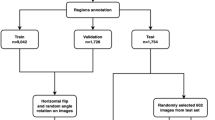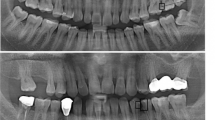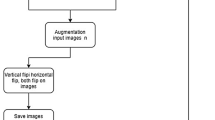Abstract
Caries grading plays a significant role for oral health management and treatment planning. Grading caries on panoramic image is a challenging task due to complication and diversity of gray distribution. In this paper, we proposed an automatic and visualized caries grading method for panoramic image using deep learning-based tooth anatomical segmentation and regions intersection judgment to achieve a consistent grading process with dentist. To achieve accurate semantic segmentation, a modified U-Net model by adding ASPP module and boundary loss is applied to segment caries, enamel, dentin, and pulp tissue region. Then a visualized process is conducted to judge the intersection of carious region and decision-making line for grading of shallow, medium, deep caries. Experimental results demonstrate our method achieves promising grading performance. Moreover, we validated that our proposed two-stage caries grading method outperform deep learning classification models. Ablation analysis of anatomical segmentation performance was also investigated, and the compared results show that our proposed modified U-Net model can obtain more accurate region and boundary to improve grading results. Some mis-graded cases were finally detailed analyzed. Our proposed caries grading approach has great potential for clinical aided diagnosis and automatic chart filling on panoramic radiographs.














Similar content being viewed by others

Data availability
The datasets analysed during the current study are not publicly available due privacy but are available from the corresponding author on reasonable request.
References
Black GV (1917) A Work on operative dentistry v. 2. Medico-dental publishing Company 2, Chicago
Caliva F, Iriondo C, Martinez AM, Majumdar S, Pedoia V (2019) Distance map loss penalty term for semantic segmentation. arXiv preprint arXiv:1908.03679
Chen L-C, Papandreou G, Kokkinos I, Murphy K, Yuille AL (2017) Deeplab: semantic image segmentation with deep convolutional nets, atrous convolution, and fully connected crfs. IEEE Trans Pattern Anal Mach Intell 40(4):834–848
Chen L-C, Papandreou G, Schroff F, Adam H (2017) Rethinking atrous convolution for semantic image segmentation. arXiv preprint arXiv:1706.05587
Chen L-C, Zhu Y, Papandreou G, Schroff F, Adam H (2018) Encoder-decoder with atrous separable convolution for semantic image segmentation. In: Proceedings of the European conference on computer vision (ECCV), pp 801–818
Chen X, Williams BM, Vallabhaneni SR, Czanner G, Williams R, Zheng Y (2019) Learning active contour models for medical image segmentation. In: Proceedings of the IEEE/CVF conference on computer vision and pattern recognition, pp 11632–11640
Das S, Kharbanda K, Suchetha M, Raman R, Dhas E (2021) Deep learning architecture based on segmented fundus image features for classification of diabetic retinopathy. Biomed Signal Process Control 68:102600
Fang L, Wang C, Li S, Rabbani H, Chen X, Liu Z (2019) Attention to lesion: lesion-aware convolutional neural network for retinal optical coherence tomography image classification. IEEE Trans Med Imaging 38(8):1959–1970
Fu J, Liu J, Tian H, Li Y, Bao Y, Fang Z, Lu H (2019) Dual attention network for scene segmentation. In: Proceedings of the IEEE/CVF conference on computer vision and pattern recognition, pp 3146–3154
Gao X, Lin S, Wong TY (2015) Automatic feature learning to grade nuclear cataracts based on deep learning. IEEE Trans Biomed Eng 62(11):2693–2701
Goldberg M (2016) Understanding dental caries. Springer, Switzerland
Goldberg M (2020) Enamel and dentin carious lesions. JSM Dent 8(1):11–20
Haghanifar A, Majdabadi MM, Ko S-B (2020) Paxnet: dental caries detection in panoramic x-ray using ensemble transfer learning and capsule classifier. arXiv preprint arXiv:2012.13666
Han Y, Li X, Wang B, Wang L (2021) Boundary loss-based 2.5 d fully convolutional neural networks approach for segmentation: a case study of the liver and tumor on computed tomography. Algorithms 14(5):144
Hwang J-J, Jung Y-H, Cho B-H, Heo M-S (2019) An overview of deep learning in the field of dentistry. Imaging Sci Dent 49(1):1–7
Ismail AI, Sohn W, Tellez M, Amaya A, Sen A, Hasson H, Pitts NB (2007) The international caries detection and assessment system (icdas): an integrated system for measuring dental caries. Commun Dent Oral Epidemiol 35(3):170–178
Ismail AI, Pitts NB, Tellez M (2015) The international caries classification and management system (iccms™) an example of a caries management pathway. BMC Oral Health 15(1):1–13
Jader G, Fontineli J, Ruiz M, Abdalla K, Pithon M, Oliveira L (2018) Deep instance segmentation of teeth in panoramic x-ray images. In: 2018 31st SIBGRAPI Conference on Graphics, Patterns and Images (SIBGRAPI). IEEE, pp 400–407
Jadon S (2020) A survey of loss functions for semantic segmentation. In: 2020 IEEE Conference on Computational Intelligence in Bioinformatics and Computational Biology (CIBCB). IEEE, pp 1–7
Jurdi RE, Petitjean C, Honeine P, Cheplygina V, Abdallah F (2021) A surprisingly effective perimeter-based loss for medical image segmentation. In: Medical imaging with deep learning. PMLR, pp 158–167
Karimi D, Salcudean SE (2019) Reducing the hausdorff distance in medical image segmentation with convolutional neural networks. IEEE Trans Med Imaging 39(2):499–513
Kassebaum N, Bernabé E, Dahiya M, Bhandari B, Murray C, Marcenes W (2015) Global burden of untreated caries: a systematic review and metaregression. J Dent Res 94(5):650–658
Kervadec H, Bouchtiba J, Desrosiers C, Granger E, Dolz J, Ayed IB (2019) Boundary loss for highly unbalanced segmentation. International conference on medical imaging with deep learning. PMLR, pp 285–296
Koch TL, Perslev M, Igel C, Brandt SS (2019) Accurate segmentation of dental panoramic radiographs with u-nets. In: 2019 IEEE 16th International Symposium on Biomedical Imaging (ISBI 2019). IEEE, pp 15–19
Lee J-H, Kim D-H, Jeong S-N, Choi S-H (2018) Detection and diagnosis of dental caries using a deep learning-based convolutional neural network algorithm. J Dent 77:106–111
Leo LM, Reddy TK (2021) Learning compact and discriminative hybrid neural network for dental caries classification. Microprocess Microsyst 82:103836
Li Y, Huang M, Zhang Y, Chen J, Xu H, Wang G, Feng W (2020) Automated gleason grading and gleason pattern region segmentation based on deep learning for pathological images of prostate cancer. IEEE Access 8:117714–117725
Lin D, Ji Y, Lischinski D, Cohen-Or D, Huang H (2018) Multi-scale context intertwining for semantic segmentation. In: Proceedings of the European Conference on Computer Vision (ECCV), pp 603–619
Martinez-Murcia FJ, Ortiz A, Ramírez J, Górriz JM, Cruz R (2021) Deep residual transfer learning for automatic diagnosis and grading of diabetic retinopathy. Neurocomputing 452:424–434
Mohan G, Subashini MM (2018) MRI based medical image analysis: Survey on brain tumor grade classification. Biomed Signal Process Control 39:139–161
Mount G, Tyas M, Duke E, Lasfargues J, Kaleka R, Hume W (2006) A proposal for a new classification of lesions of exposed tooth surfaces. Int Dent J 56(2):82–91
Nagpal K, Foote D, Liu Y, Chen P-HC, Wulczyn E, Tan F, Olson N, Smith JL, Mohtashamian A, Wren JH et al (2019) Development and validation of a deep learning algorithm for improving gleason scoring of prostate cancer. NPJ Digit Med 2(1):1–10
Naser MA, Deen MJ (2020) Brain tumor segmentation and grading of lower-grade glioma using deep learning in mri images. Comput Biol Med 121:103758
Qiu M, Zhang C, Song Z (2022) Dynamic boundary-insensitive loss for magnetic resonance medical image segmentation. Med Phys 49(3):1739–1753
Qureshi I, Ma J, Abbas Q (2021) Diabetic retinopathy detection and stage classification in eye fundus images using active deep learning. Multimed Tools Appl 80(8):11691–11721
Ronneberger O, Fischer P, Brox T (2015) U-net: convolutional networks for biomedical image segmentation[C]. International Conference on Medical image computing and computer-assisted intervention. Springer, Cham, pp 234–241
Sajjad M, Khan S, Muhammad K, Wu W, Ullah A, Baik SW (2019) Multi-grade brain tumor classification using deep CNN with extensive data augmentation. J Comput Sci 30:174–182
Silva G, Oliveira L, Pithon M (2018) Automatic segmenting teeth in x-ray images: trends, a novel data set, benchmarking and future perspectives. Expert Syst Appl 107:15–31
Singh P, Sehgal P (2021) GV black dental caries classification and preparation technique using optimal cnn-lstm classifier. Multimed Tools Appl 80(4):5255–5272
Sinha A, Dolz J (2020) Multi-scale self-guided attention for medical image segmentation. IEEE J Biomed Health Inf 25(1):121–130
Stidham RW, Liu W, Bishu S, Rice MD, Higgins PD, Zhu J, Nallamothu BK, Waljee AK (2019) Performance of a deep learning model vs human reviewers in grading endoscopic disease severity of patients with ulcerative colitis. JAMA Netw open 2(5):e193963–e193963
Sultan HH, Salem NM, Al-Atabany W (2019) Multi-classification of brain tumor images using deep neural network. IEEE Access 7:69215–69225
Tao A, Sapra K, Catanzaro B (2020) Hierarchical multiscale attention for semantic segmentation. arXiv preprint arXiv:2005.10821
Tran S-T, Cheng C-H, Nguyen T-T, Le M-H, Liu D-G (2021) Tmd-unet: triple-unet with multi-scale input features and dense skip connection for medical image segmentation. Healthcare 9(1):54. Multidisciplinary Digital Publishing Institute
Tuzoff DV, Tuzova LN, Bornstein MM, Krasnov AS, Kharchenko MA, Nikolenko SI, Sveshnikov MM, Bednenko GB (2019) Tooth detection and numbering in panoramic radiographs using convolutional neural networks. Dentomaxillofacial Radiol 48(4):20180051
Vinayahalingam S, Kempers S, Limon L, Deibel D, Maal T, Hanisch M, Bergé S, Xi T (2021) Classification of caries in third molars on panoramic radiographs using deep learning. Sci Rep 11(1):1–7
Wang Y, Yu M, Hu B, Jin X, Li Y, Zhang X, Zhang Y, Gong D, Wu C, Zhang B et al (2021) Deep learning-based detection and stage grading for optimising diagnosis of diabetic retinopathy. Diabetes Metab Res Rev 37(4):e3445
Wang X, Li Z, Huang Y, Jiao Y (2022) Multimodal medical image segmentation using multi-scale context-aware network. Neurocomputing 486:135–146
Whaites E, Drage N (2013) Essentials of dental radiography and radiology. Elsevier Health Sciences, London
Xu X, Zhang L, Li J, Guan Y, Zhang L (2019) A hybrid global-local representation cnn model for automatic cataract grading. IEEE J Biomed Health Inf 24(2):556–567
Yang D, Wang J, Lu G (2002) An algorithm for automatically generating centerlines between curves(in Chinese). Bull Surveying Mapp 3:58–60
Yang Q, Ku T, Hu K (2021) Efficient attention pyramid network for semantic segmentation. IEEE Access 9:18867–18875
Yang Q, Xu Z, Liao C, Cai J, Huang Y, Chen H, Tao X, Huang Z, Chen J, Dong J et al (2020) Epithelium segmentation and automated gleason grading of prostate cancer via deep learning in label-free multiphoton microscopic images. J Biophotonics 13(2):e201900203
Zeller G, Young DA, Novy B (2019) The american dental association caries classification system (ada ccs). In: Detection and assessment of dental caries. Springer, pp 57–67
Zhang J, Jin Y, Xu J, Xu X, Zhang Y (2018) Mdu-net: multiscale densely connected u-net for biomedical image segmentation. arXiv preprint arXiv:1812.00352
Zhang X, Liang Y, Li W, Liu C, Gu D, Sun W, Miao L (2022) Development and evaluation of deep learning for screening dental caries from oral photographs. Oral Dis 28(1):173–181
Zhao H, Shi J, Qi X, Wang X, Jia J (2017) Pyramid scene parsing network. Proceedings of the IEEE conference on computer vision and pattern recognition, pp 2881–2890
Zhao S, Wang Y, Yang Z, Cai D (2019) Region mutual information loss for semantic segmentation. Adv Neural Inf Process Syst 32
Zhou Z, Rahman Siddiquee MM, Tajbakhsh N, Liang J (2018) Unet++: a nested u-net architecture for medical image segmentation. In: Deep learning in medical image analysis and multimodal learning for clinical decision support. Springer, pp 3–11
Zhu H, Cao Z, Lian L et al (2022) CariesNet: a deep learning approach for segmentation of multi-stage caries lesion from oral panoramic X-ray image. Neural Comput Appl:1–9
Acknowledgements
This work was supported by the Fundamental Research Funds for the Zhejiang Provincial Universities (2021XZZX033), Natural Science Foundation of Zhejiang Province (LZY21F030002), Department of Science and Technology of Zhejiang Province (Y202045833).
Author information
Authors and Affiliations
Corresponding author
Ethics declarations
The researcher claims no conflicts of interests.
Additional information
Publisher’s note
Springer Nature remains neutral with regard to jurisdictional claims in published maps and institutional affiliations.
Rights and permissions
Springer Nature or its licensor (e.g. a society or other partner) holds exclusive rights to this article under a publishing agreement with the author(s) or other rightsholder(s); author self-archiving of the accepted manuscript version of this article is solely governed by the terms of such publishing agreement and applicable law.
About this article
Cite this article
Chen, Q., Huang, J., Zhu, H. et al. Automatic and visualized grading of dental caries using deep learning on panoramic radiographs. Multimed Tools Appl 82, 23709–23734 (2023). https://doi.org/10.1007/s11042-022-14089-z
Received:
Revised:
Accepted:
Published:
Issue Date:
DOI: https://doi.org/10.1007/s11042-022-14089-z



